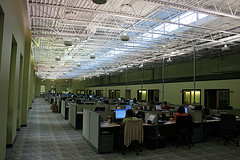One of the most revolutionaries scientific studies ever conducted on the issue of workplace  productivity took place in the 1920s, but still holds true today. The Hawthorne Effect is a business management discovery that initially focused on that initially focused on efficient use of office space by studying the effect of lighting on workplace productivity. Ultimately, the science switched from the biological to the psychological with surprising results that open up broad avenues of possibilities for office workers of all types.
productivity took place in the 1920s, but still holds true today. The Hawthorne Effect is a business management discovery that initially focused on that initially focused on efficient use of office space by studying the effect of lighting on workplace productivity. Ultimately, the science switched from the biological to the psychological with surprising results that open up broad avenues of possibilities for office workers of all types.
You would think that Hawthorne was the name of the social scientist who discovered the titular effect, but that would be the wrong assumption. The Hawthorne Effect was named after Western Electric’s Hawthorne plant near Chicago. The scientist was Elton Mayo and Western Electric had hired him in 1927 initially for the purpose of determining whether lighting levels impacted workplace productivity. As the study continued, however, Mayo realized something much more subtle was going on. Over time, Mayo expanded his research on workplace productivity to include additional stimuli ranging from more flexible schedules to increased daily breaks and other incentives.
By the time Mayo wrapped up his research in 1932, the conclusion was a foregone piece of simple common sense. The Hawthorne Effect essentially asserts that the one single constant when it comes to increasing workplace productivity is increasing the perception among workers that management is making them feel important by observing them.
A direct result of the development of the Hawthorne Effect was the development of a number of incentive programs designed to address worker needs while also instituting the belief among the workers that management was willing to tend to their future. The 21st century version of this workplace strategy that was the offspring of the Hawthorne Effect study can be found in every office that features an on-site gym, child care nursery, fully functioning kitchen, gourmet coffee shop, comfortably designed smoking area and basketball court.
The downside to this landmark study in workplace productivity is just as vital to understand when designing a strategy for your office workspace. While management should take any steps that make economic sense to design an office that make the workers feel valuable while also allowing them their behavior to be openly observed, keep in mind that there is always a shelf life involved. While the Hawthorne Effect has been proven effective whether the office was populated by a half-dozen workers or a hundred, the effect is bound to wear out without consistent stimulation. Employee production rises when management addresses a workplace issue, but as that issue gradually evolves into the status quo, new issues must be dealt with whenever they rise to become obstructions to workplace productivity.
Only if management deals effectively with those new workplace issues in a way that increases the perception that their observation and recognition of worker issues is genuinely about care for the office employees will the Hawthorne Effect takes over and make everybody happy and productive once again.
If you are looking into ways to make a more efficient use of your office space, Contact us today to learn more.
